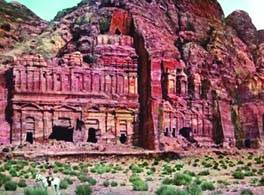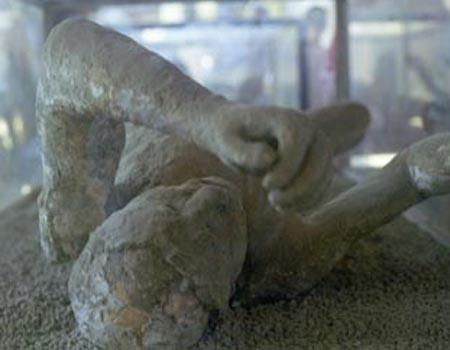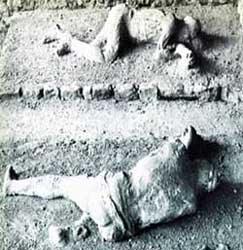 Accounts of peoples of ancient times comprise a rather large part of the Qur’an and contain important wisdom well worthy our reflection. When we examine individuals who lived — and were wiped out — in the past, we can see that they had no fear of Allah, despite the messages communicated to them. They engaged in ugly, deviant practices, and rode roughshod over the rights of others. Accounts of peoples of ancient times comprise a rather large part of the Qur’an and contain important wisdom well worthy our reflection. When we examine individuals who lived — and were wiped out — in the past, we can see that they had no fear of Allah, despite the messages communicated to them. They engaged in ugly, deviant practices, and rode roughshod over the rights of others. They had lost all sense of shame, and thought only of their own concerns and worldly interests. But the most serious fault they shared in common was rejecting the prophets whom Allah sent to them, and even being openly hostile towards them. Because of their obstinacy, Allah punished them and wiped them suddenly from the face of the Earth. In the Qur’an, Allah reveals that He intended these acts of destruction as a deterrent to those who came after them. It’s important for all believers not to regard these events as experienced solely by peoples who lived in the past, but to learn from these examples provided in the Qur’an. As is revealed in the Qur’an:
Where Did the People of ‘Ad Live? The people of ‘Ad, who “build a tower on every hilltop” (Qur’an, 26:128) and “construct great fortresses” (Qur’an, 26:129), lived in southern Arabia — a region distant from the other peoples in the Middle East and Mesopotamia. The Truth Revealed by Archaeological Findings At the beginning of 1990, press releases appeared in well-known newspapers around the world with such headlines as "Fabled Lost Arabian City Re-Discovered, " and " Found: Arabian City of Legend, ", and "Ubar - the Atlantis of the Sands." What made this archaeological discovery still more fascinating was that the city’s name appears in the Qur’an. Many people were amazed in the face of this new discovery, having assumed that the People of ‘Ad, referred to in the Qur’an, would never be found. The People of ‘Ad and the Columns The excavations at Ubar unearthed a great  many artistic relics and works of advanced civilization, of the kind revealed in the Qur’an. many artistic relics and works of advanced civilization, of the kind revealed in the Qur’an.From the moment these remains were first unearthed, it was realized that this ruined city was the city of Iram, home to the people of ‘Ad referred to in the Qur’an. Among the structures unearthed were columns, whose existence is mentioned in the Qur’an. Dr. Zarins, of the team that carried out the excavation, stated that these pillars were chiefly what made this city different from other archaeological discoveries, and that this, therefore, was the city of the “People of ‘Ad” referred to in the Qur’an. In the Qur’an, the city of Iram is referred to thus:
The Prophet Hud (as) was sent as an envoy to ‘Ad, and told the people that he was a trustworthy envoy sent to them by Allah, called on them to fear Him and avoid His wrath. He warned them to serve only Allah, or else He would punish them. Despite all his exhortations, however, the deviant people of ‘Ad opposed the Prophet Hud (as) and refused to follow the path he had set out for them. Their ugly behavior toward his message is reported in these verses: Why were the People of ‘Ad destroyed? Their Slandering of the Prophet The ruling circle of those of his people who disbelieved said, “We consider you a fool and think you are a liar.” (Qur’an, 7:66) Their Ascription of Partners to Allah
Their Rejection of the Prophet
Their Pride
They Brought Their Punishment upon Themselves
As revealed in these verses, Allah punished the people of ‘Ad who failed to heed the Prophet Hud (as)’s call, like every other people who failed to comply with religious moral values, and He inflicted losses on them in this world and in the Hereafter. The Qur’an reveals that the destruction of the people of ‘Ad came in the form of a sandstorm that burst their eardrums. The verses tell us that this sandstorm lasted seven whole nights and eight entire days (Qur’an, 69:7), and completely destroyed ‘Ad:
This tribe had been warned previously, but they took no heed of this warning and constantly denied the Prophet. So heedless were they that even when destruction was heading their way. still they persisted in their denial. This, too, is revealed in the Qur’an:
The verse tells us that when the tribe saw the cloud that would bring chastisement to them, they failed to understand what it really was and imagined it to be a rain cloud. This may be an important indication of what the punishment inflicted on them really was, because from a distance, a whirlwind that lifts the desert sand as it moves does indeed resemble a rain cloud. The people of ‘Ad may have been deceived by this appearance and failed to realize that punishment was approaching. (Allah knows the truth.) The archaeologist Brian Doe, who carries out research in Southern Arabia, describes a sandstorm thus:
Indeed, "The Atlantis of the Sands, " thought to be the remains of the people of ‘Ad, was unearthed from below a layer of sand many meters thick. As the remains of Ubar also show, the storm that evidently lasted “seven nights and eight days,” as revealed in the Qur’an, piled tons of sand over the city and buried the inhabitants alive.  The People of Thamud in History The People of Thamud in History Just like the people of ‘Ad, the inhabitants of Thamud ignored Allah’s warnings and were therefore destroyed. As a result of modern-day archaeological and historical research, many formerly unknown details — such as where the tribe lived, the houses they built, and their way of life — were all brought to light. The people of Thamud, mentioned in the Qur’an, are today known to history, and we have much archaeological knowledge about them. Where Did the People of Thamud Live? The community of al-Hijr mentioned in the Qur’an and the tribe of Thamud are believed to be actually one and the same. Indeed, another name for the tribe of Thamud is Ashab al-Hijr. It may well be, therefore, that the word “Thamud” refers to the name of the people, and that the city of al-Hijr is just one of the cities they built. The Greek geographer Pliny’sdescriptions agree with this. Pliny wrote that Domatha and Hegra were the locations where Thamud resided, and this latter makes up the city of al-Hijr today. ("Hicr", Islam Ansiklopedisi: Islam Alemi, Tarihi, Cografya, Etnografya ve Bibliyografya Lugati, (Encyclopedia of Islam: Islamic World, History, Geography, Ethnography, and Bibliography Dictionary) Vol. 5/1, p. 475) The Prophet Salih was Sent to Them
They Killed a Female Camel Despite all the warnings from the Prophet Salih (as), the people of Thamud still doubted the existence of Allah (Surely Allah is beyond that!) and the prophethood of Salih (as). At Allah’s revelation the Prophet Salih (as) showed the tribe a female camel to test whether they would abide by Allah’s command. In order to determine whether they would obey him or not, he subjected them to a test by telling them to share their water with the camel and not to harm it. . Their response to the Prophet Salih (as) was to kill the camel. These events are reported in Surat ash-Shu‘ara’:
They Fought Against the Prophet
"You are nothing but a human being like ourselves, so produce a Sign if you are telling the truth." (Qur’an, 26:154) They Refused to Accept the Existence of Allah
How Were the People of Thamud Destroyed? The people of Thamud were punished immediately after they had killed the camel sent to test them. This encouraged their excesses, and they continued to respond to the Prophet Salih (as) in an ugly and unrestrained manner:
However, Almighty Allah confounded the deniers’plans and rescued the Prophet Salih (as) from those who wished to do him harml. It is revealed in the Qur’an that after this the Prophet Salih (as) continued to preach his message. But that seeing that nobody heeded his advice, he announced that the tribe would be destroyed within three days:
Indeed, three days later, his warning became a reality, and the people of Thamud were destroyed:
CONCLUSION The peoples we have examined so far possessed certain features in common, such as failing to have faith in Allah, ascribing partners to Him, denying the prophets, displaying unjustified pride, usurping others’ goods, showing sexual deviancy and excess, and oppressing the Muslims around them. In the Qur’an, it is revealed that all this information has been provided as a deterrent. Those destroyed in the past must impel those who come after them towards the truth:
|
TOPICS
VaticanSocialismIlluminationFrench RevolutionConvertSabbateanJacobinismMasonic MediaPolitical ZionismYoung TurkThe Committee of Union and ProgressAbdulhamidAnti-NaziWorld Zionist Organization Nuremberg LawsMussoliniWorld War IAdolf EichmannGoyimThe Rothschild DynastyThink-ThankCFRRockefellerCold WarStalinOctober RevolutionSoviet UnionBilderbergVietnamAIPACLobbyfairSoutheastGreeceNew World OrderRed Seageopoliticsveterantaxcustoms2023antelopebullEurasia Islam CouncilNobel PrizeHospitalSocial Security InstitutionAli BabacanTurgut OzalassassinationGaffar OkkanMuhsin YazıcıoğluRosetta NebulaAstronomyRose


